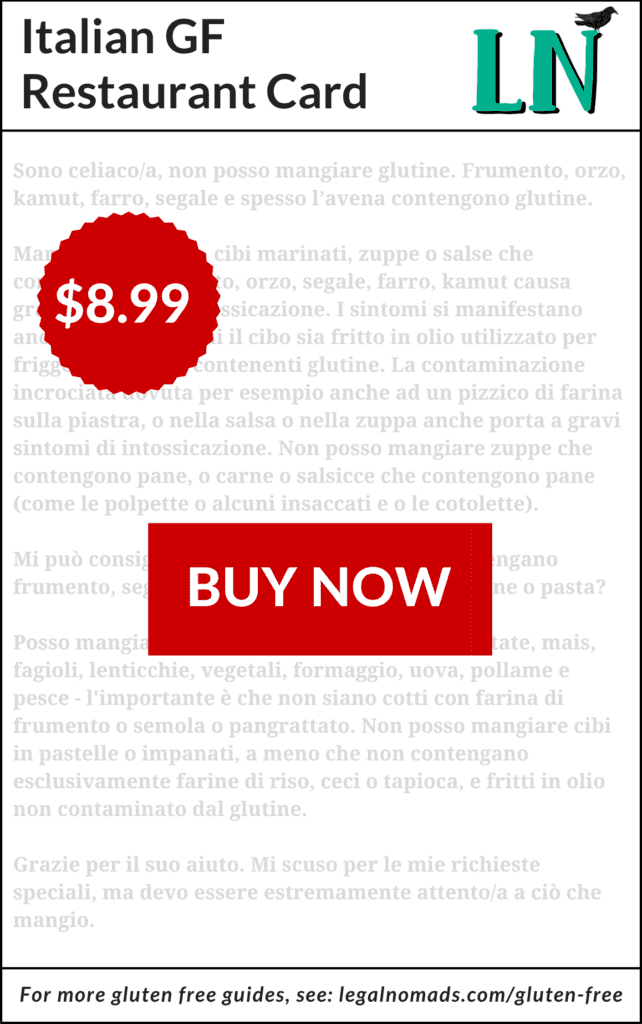Gluten Free Venice: A Complete Guide (for Foodies)
I think that most people – particularly Americans – tend to visit Venice for the first time as a part of a broader itinerary that takes them to the rest of Italy.
Compared to other Italian cities like Rome, Florence, and Milan – which are all top-tier gluten free food cities – Venice is…disappointing.
And, to be clear, Venice is a MUCH smaller city than those other cities, so it sort of makes sense.
Generally speaking, the bigger the city, the more gluten free options you’ll find.
The impact of Venice’s geographical constraints (the whole built on a lagoon thing makes it harder to build out or up) means that there is just limited space, and one of the casualties of those constraints is the gluten free food scene.
For example, there is at least one (usually more) excellent gluten free bakery in those other three Italian cities that I mentioned above. There are exactly zero gluten free bakeries in Venice.
That limited space combined with the fact that Venetian cuisine is heavy on seafood (and I’m not super into seafood, if we’re being honest) means that Venice is pretty clearly my least favorite (gluten free) food city of the major cities in Italy.
In this guide, we’ll go through our take on the best places to eat gluten free in Venice, though it’s a shorter list than we normally have for the reasons we covered above.
We’ll give you a breakdown of the best gluten free restaurants along with the best places to find gluten free groceries if you’re looking for snacks or ingredients to cook at your accommodations.
At the end, we’ll give you a handy map so you can visualize where to find each place we mention (and how they might fit together).
Sound good to you? Let’s get into it.

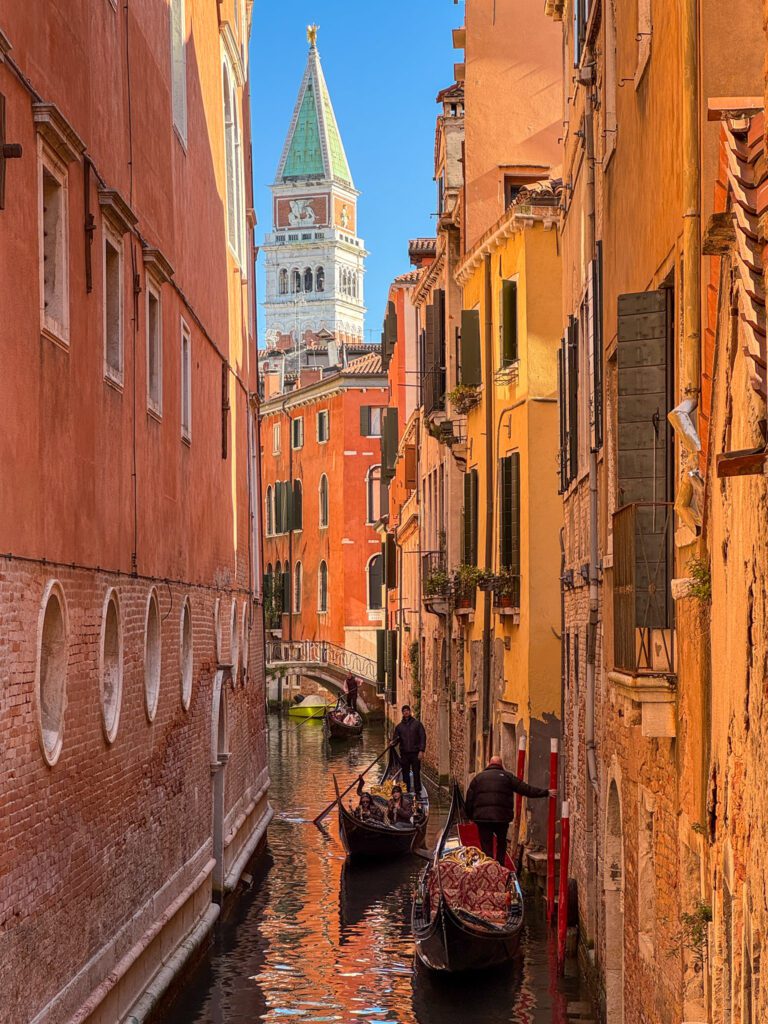
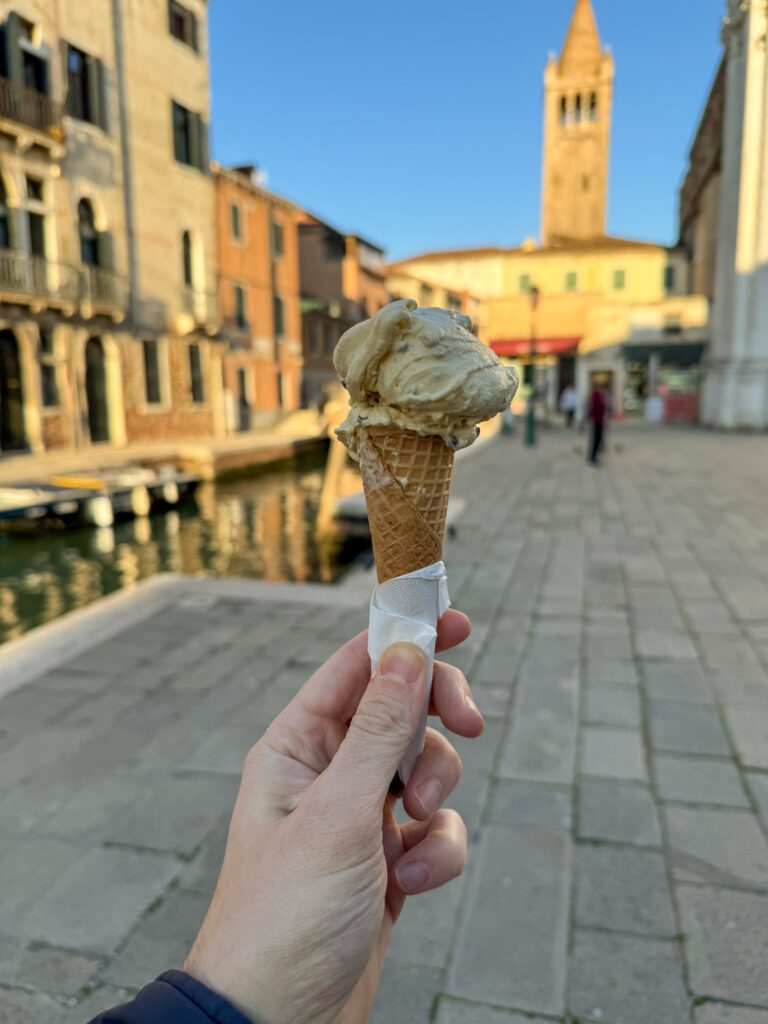
Disclaimer: Some of the links in this post, like hotel links, are affiliate links, meaning at no additional cost to you, we make a little bit of money if you click through and book. That being said, we would never recommend something to you that we don’t stand behind 100%.
Tips for Visiting Venice and Eating Gluten Free
Before we get into specific restaurants in Venice that we’d recommend, let’s quickly cover some things we think you should know before you visit.
The Italian Celiac Association (AIC) is Amazing
At a high level, the AIC – Associazione Italiana Celiachia in Italian – educates restaurants in Italy on how to safely serve Celiacs a gluten free meal, from sourcing ingredients to separating equipment and surfaces in the kitchen.
It’s a revelation, coming from the US where it’s essentially a free-for-all, and terms like “gluten-friendly” have somehow become a thing, and are popping up everywhere.
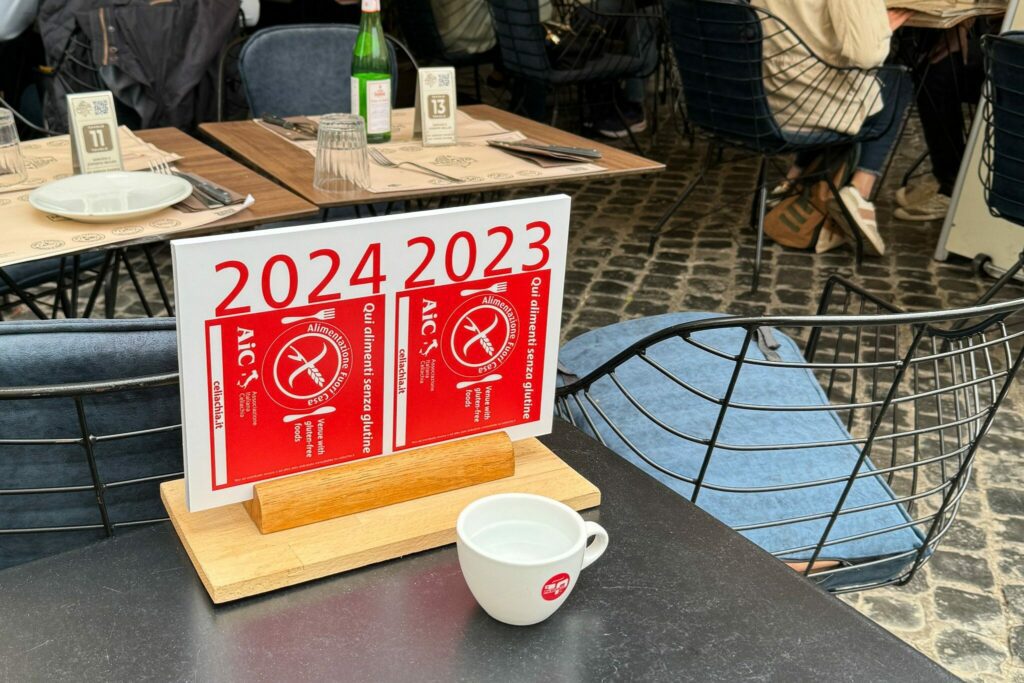
In Italy, it’s generally a good assumption that if something is AIC-accredited, they know what they’re doing.
The first thing you should do when you’re planning a gluten free trip to Italy is download the AIC app, which costs $2.99 to subscribe for two weeks to their database of accredited gluten free restaurants in Italy.
You can extend for another two weeks exactly once, and after that you’ll have to get in touch with a local association to subscribe.
In that app, they have an interactive map where you can see accredited restaurants in a given area, including the user ratings (though there’s not much detail behind the ratings).
I automatically disregarded any restaurant with a rating below 4.0, for what it’s worth.
It’s a lifesaver, and it’s better than FindMeGlutenFree, I think, though I do also use that app extensively when traveling.
Get an Italian Gluten Free Restaurant Card
A lot of people in Venice, especially in restaurants, speak English. But if you don’t speak Italian and you’re worried about communicating your needs, Jodi from Legal Nomads has a solution for you that will make eating gluten free in Italy significantly easier.
She has a gluten free restaurant card in Italian that is specifically designed for gluten free travel in Italy.
It clearly communicates our needs as Celiacs, including cross-contact and specific hidden sources of gluten found in Italy.
It will cost you $9, which is nothing in the grand scheme of your trip, and it will save you tons of stress and anxiety and help you get safe gluten free food in Italy regardless of how much Italian you speak.
Head over to Legal Nomads and pick up an Italian Gluten Free Translation Card to travel safely and confidently with Celiac Disease.
I personally use these when I travel, and they have helped me confidently and comfortably communicate my needs in the face of a language barrier.
I’ve used them in Germany to eat safely (I don’t speak German, only romance languages for me!) and also down in Colombia and Mexico, and they saved me several times in situations where my 2nd grade Spanish wasn’t quite cutting it.
They are well worth the small investment to help you feel more comfortable and confident traveling with Celiac Disease.
Click here to grab one for your trip.
Be Skeptical of Any “Gluten Free” Beer
Compared to other Italian cities, there’s a lot of gluten free beer to be found in Venice. Which I was excited about!
Until, of course, I read the labels and saw “barley malt” on every single label. Barley, as you may know, is one of the grains that contains gluten.
Which means these beers are made with barley, then an enzyme is added to break up the gluten, which interferes with the test for gluten’s ability to detect gluten. Seems sketchy, right? That’s because it is.
In both Canada and the US, you can’t call these beers gluten free.
It’s legal in the EU to label these beers as “gluten free,” and often the only way you’d know it contains barley is by looking at the ingredients.
Here’s a quick read on the difference, and why people with Celiac Disease shouldn’t drink gluten-reduced beer. Here’s another one. And I loved this open letter.
Gelato Shops are a Minefield of Cross-Contamination
The gelato goes on the cone, the scoop touches the cone, the scoop goes back into the tub, repeat as needed.
Unless you are able to communicate that you’d like a fresh scooper and a fresh container that hasn’t been opened AND they’re able to accommodate that request (most places don’t have extra tubs sitting around like some ice cream shops do in the US), then I’d stick to the 100% gluten free gelato shops, which you’ll find more information on below.
Gluten Free Wheat Starch is Fairly Common in Pizza Crusts
Another problematic ingredient! But, in my opinion, less-so than the gluten free beer example above.
In Italy, and many other E.U. countries, they use an ingredient that is essentially gluten free wheat starch, which offers some nice texture benefits when it’s used in things like pizza crust.
All of a sudden, you go from only being able to do thin crust pizzas to being able to have thick, bubbly pizza crust. MAGIC!
Admittedly, I know less about gluten free wheat starch than I do about gluten reduced beer, but I will once again refer you to Gluten Free Watchdog’s take on it (she’s so much more knowledgeable than I am on this kind of stuff) so that you can use that information to make your own decision.
However, the reason that I’m including this in its separate section is that it absolutely does matter for people with a wheat allergy! If you are eating gluten free because you have a wheat allergy, you’ll need to ask at every restaurant, particularly pizza places.
Our Favorite Gluten Free Restaurants in Venice
Matt, the resident Celiac in this corner of the internet, was diagnosed 15+ years ago, and he has learned over that time that mixed kitchens that handle a lot of flour (like pizza and pasta places) are a tough place to make a gluten free meal free from cross-contact.
Source: Our kitchen is coated in a (not-so) thin coating of gluten free flour everytime Matt makes his homemade pizza.
However, Italy is a slightly different story in some cases because they have an active Celiac Association – the AIC (Associazione Italiana Celiachia) – which helps set restaurants up for success.
Does that mean that they always follow those protocols? No – they’re still run by humans.
However, I do believe that the processes they put into place (for example, serving gluten free food on a different colored plate) make them a significantly safer option.
If you’re a Celiac, I personally believe that you should focus on places that are either dedicated gluten free (no gluten in the kitchen) or accredited by the AIC where risk of cross-contact is relatively low due to training and processes.
Which is why all of the places mentioned in this guide belong to one (or both) of those categories.
Is that a perfect way to do things? Not necessarily. I’m sure there are a couple of other places in Venice that can make a safe gluten free meal. However, I do think it’s a good shortcut.
Frary’s (AIC-Accredited)
This was, by far, the best meal I had in Venice. Though it was also the least Venetian, so if you want to try local delicacies like sarde in saor or seppie al nero, this is not the right place for that (we’ll get to those in a second).
But if you’re looking for a break from pizza and pasta and want a warm, inviting atmosphere and excellent food inspired by the eastern Mediterranean and North Africa, Frary’s is a great option.
It’s right across from Campo dei Frari and the brick church of the same name in the heart of San Polo in Central Venice.
It’s a small space, so I’d make reservations in advance if you can (either by stopping by earlier in the day, or by calling ahead).
If you made me rank the three best things I ate in Venice, the three things I had here would be number one, two, and three.
First was the antipasto misto, which is a little (or big) plate they make for you that combines a bunch of their starters (dolmas, hummus, roasted chicken, and feta were the highlights for me).
Second was a recommendation from my server – the kofta – which are beef meatballs in a slightly spicy tomato sauce served over rice. Excellent.

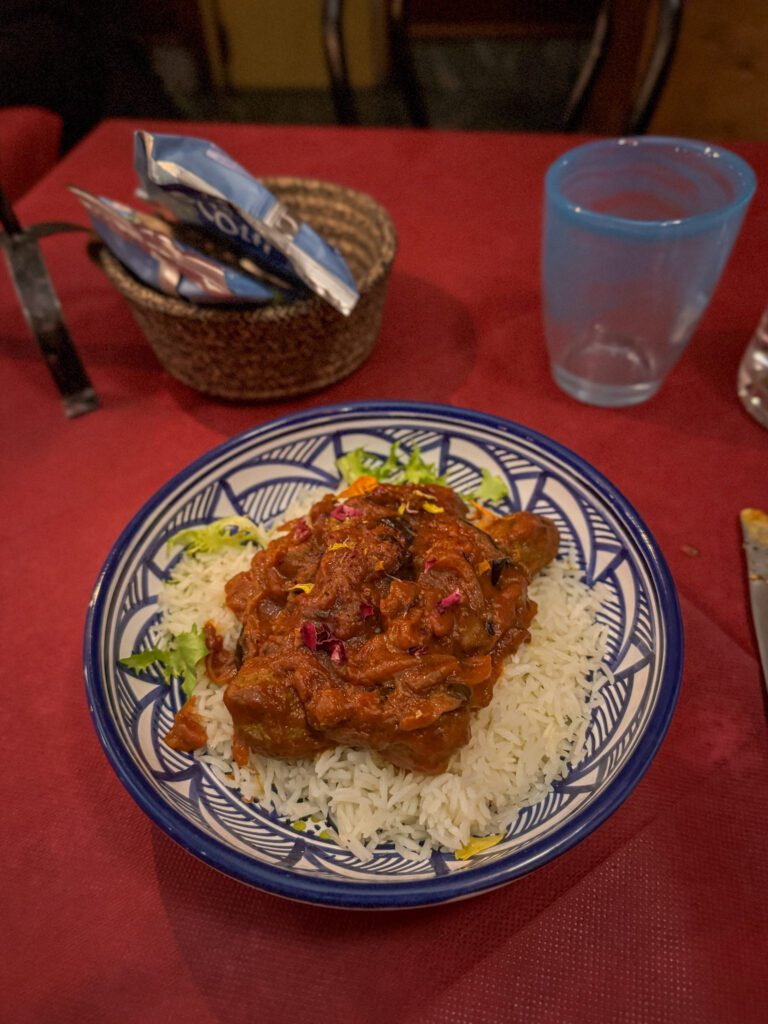
Last was the cake of the day which, in this case, was chocolate. It was light, airy, and a perfect cap to my favorite meal in Venice.
Make sure to tell them you are Celiac when you sit down, and they will walk you through the options and bring you a couple of rice cakes (instead of pita bread) for dips.
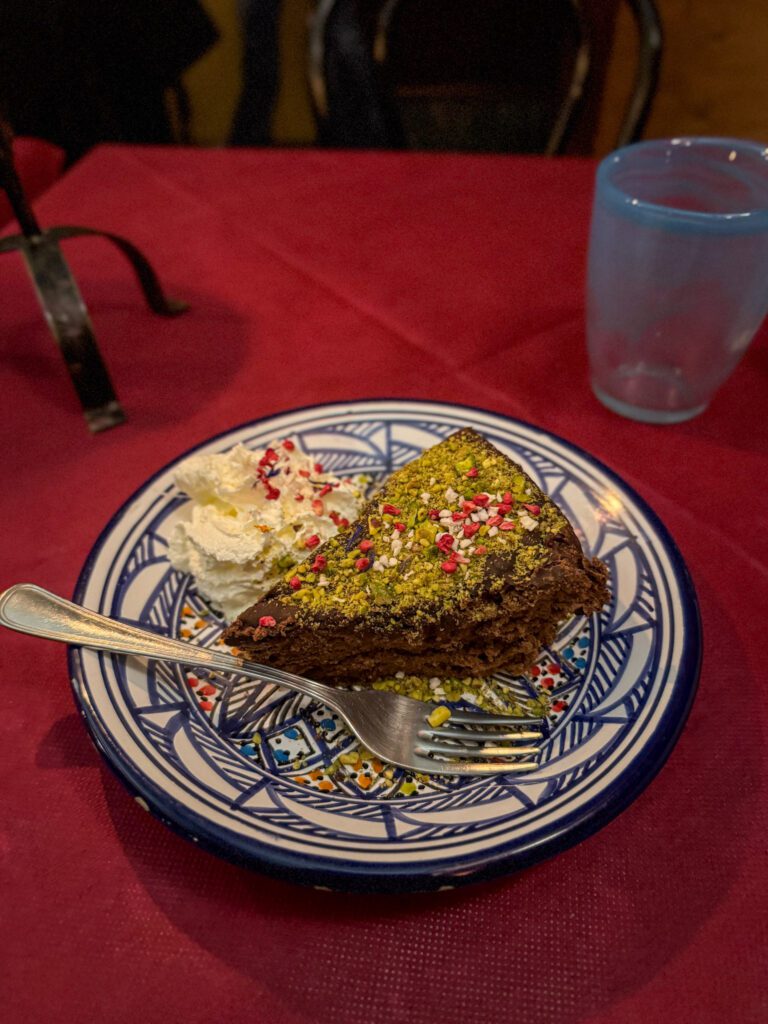
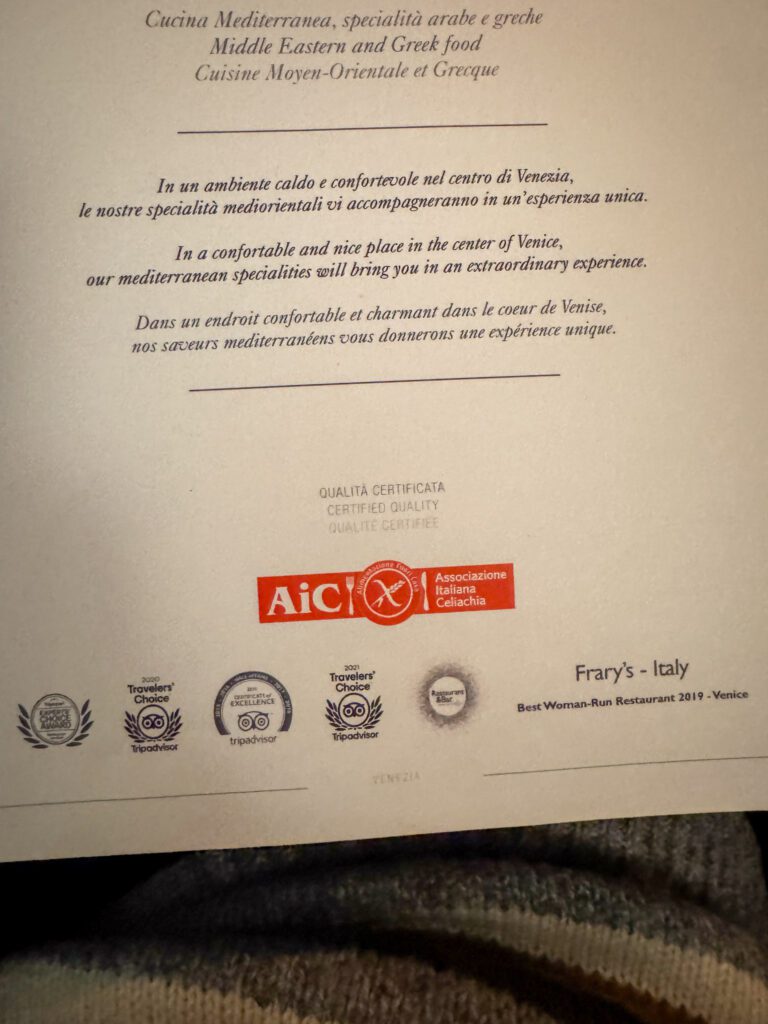
They also have a selection of Greek and Lebanese wines (among other origins), which is kind of fun and different.
La Vecia Cavana (AIC-Accredited)
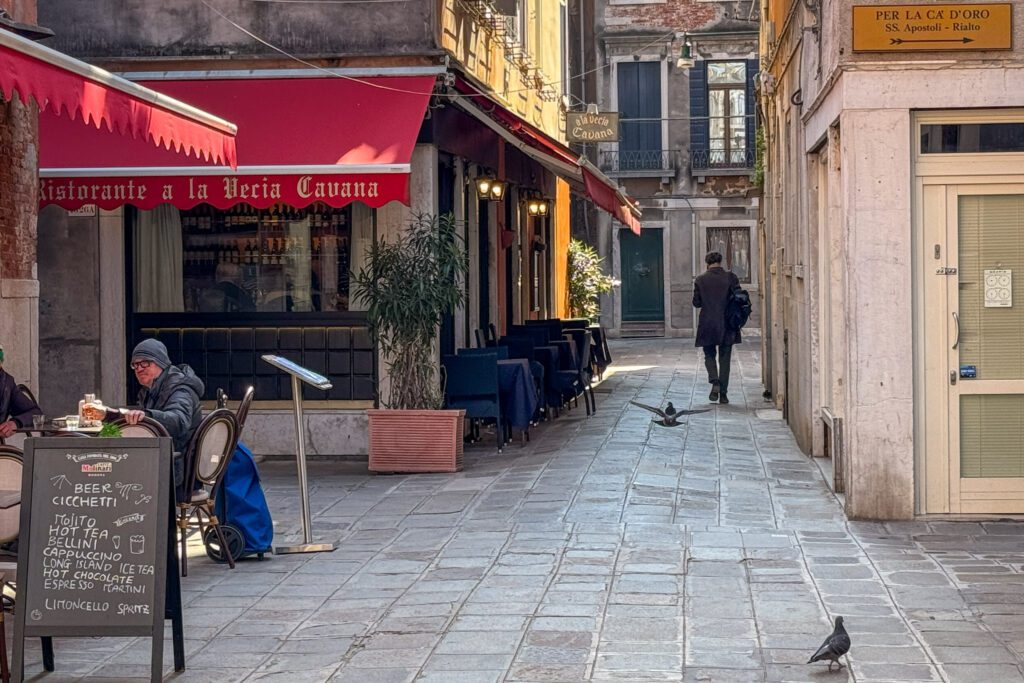
The first of two AIC-accredited places to get authentic Venetian food on this list, Vecia Cavana is my top pick of the two because of the fact that everything that goes into their fryer is made with rice flour and is thus gluten free.
Which means more choices for you! Although I’d always double check that this is still true.
This place (and the next place) feels very old school, with white tablecloths and waiters in black pants, white shirts, and aprons.
The majority of people eating here were both speaking Italian and also over the age of 50 (maybe 60?), but that doesn’t mean you shouldn’t eat here.
There were three Venetian specialties that I was on the hunt for, and I was able to find two of them here – the sarde in saor, fried sardines in a sour sauce with onions, and pasta alla busara, which is a slightly (heavy on the slightly) spicy tomato sauce with pasta and scampi.
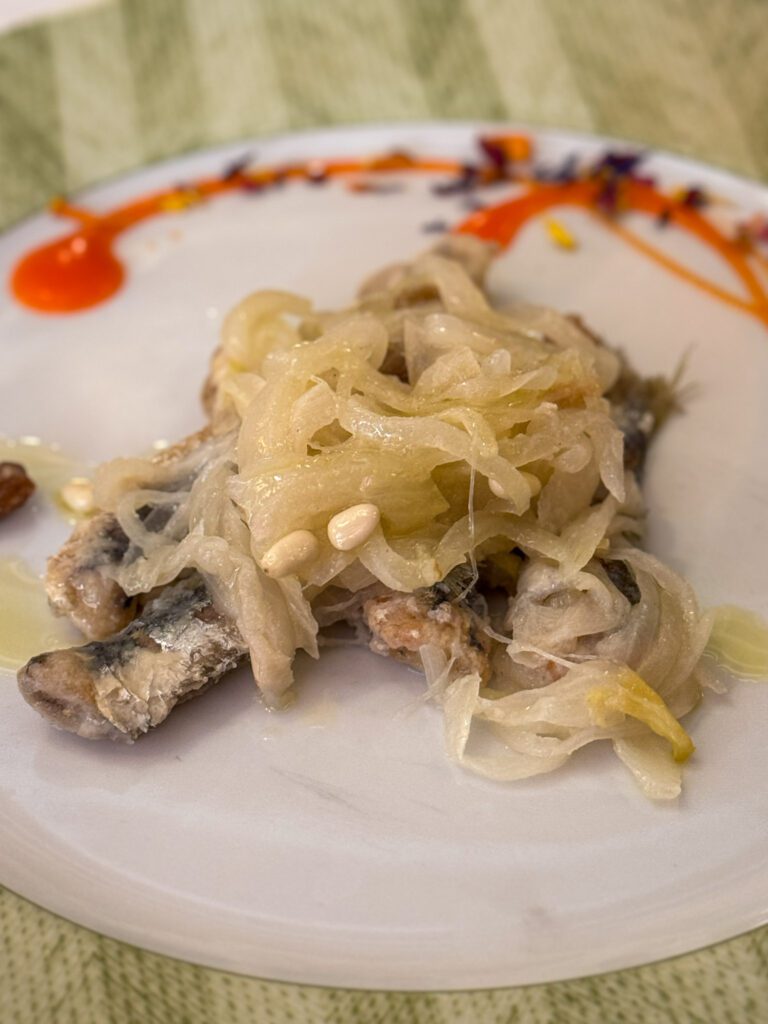
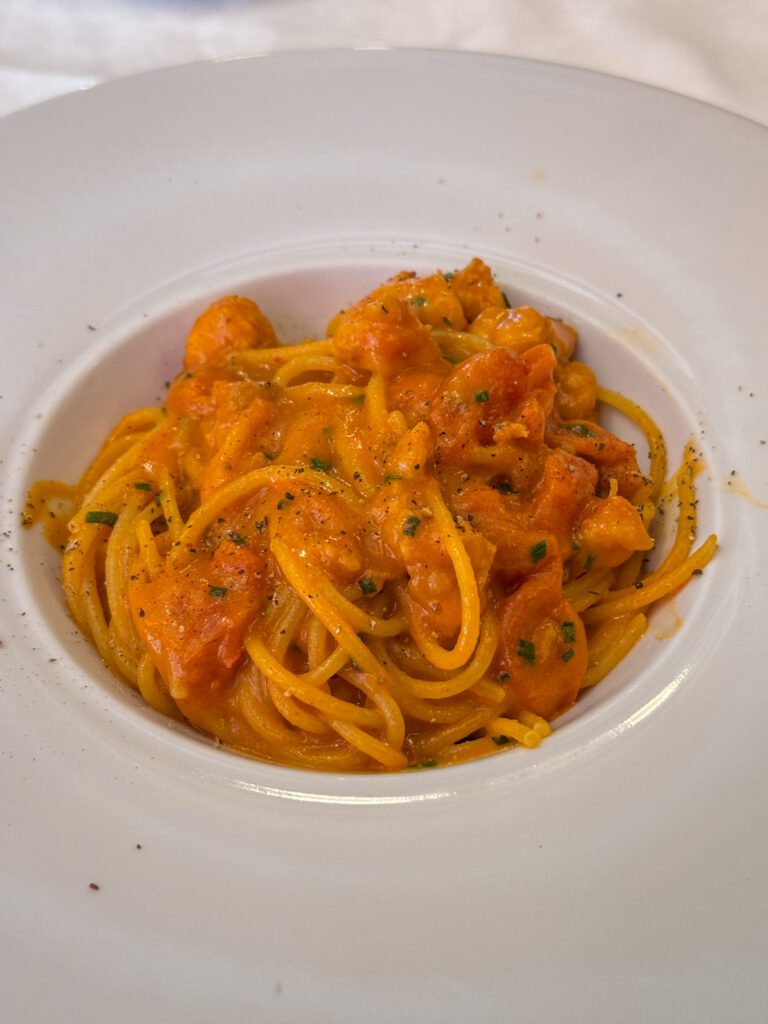
The sarde were worth trying, but I probably wouldn’t order them again (at least partially because I’m always confused about how to eat them and at what size it’s no longer appropriate to eat the bones).
The pasta was pretty good, but was missing the spice that the description (and my previous research) had promised.
I declined dessert, but they did have a gluten free tiramisu and a cheesecake.
Make sure to tell them that you are Celiac (or gluten free) immediately when you sit down and they will remove the bread and bring you a side of crackers and gluten free bread (which are included in the €5 cover charge that they charge per person).
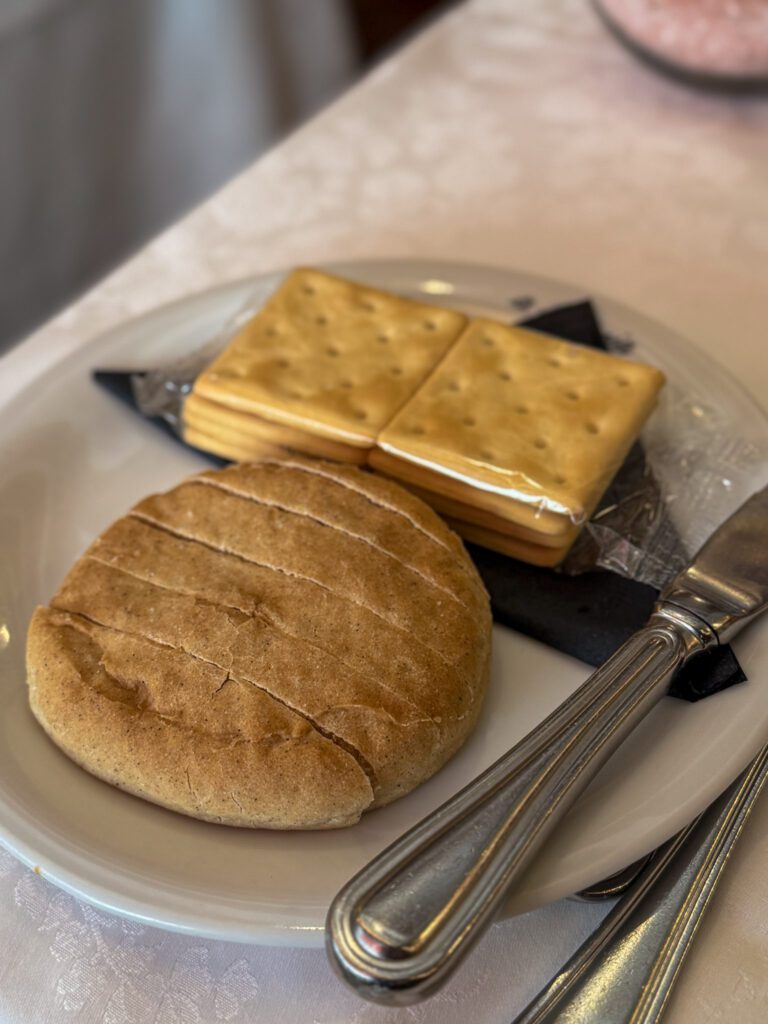
I will say that, despite doing my best to speak Italian (which was rusty as it was my first day in Italy), I was unable to blend in and was definitely pegged as an American and treated as such (an incessant reminder that tip isn’t included in the bill from the start of the meal to the end).
They also made some completely unnecessary comments about my decision not to drink alcohol which didn’t really bother me, but rather baffled me because I didn’t understand the point (has shaming someone into ordering wine ever worked, I wonder?).
Anyway, service aside, I thought the food was pretty good and the ability to order anything fried is a major plus.
Al Giardinetto da Severino (AIC-Accredited)

Let my mistakes at Al Giardinetto da Severino be a lesson to you – I was jetlagged, tired, and completely unprepared when I sat down and the waiter immediately asked me what I wanted, and I completely forgot to tell him that I was a Celiac AND ordered something that contained gluten (even though the menu is clearly marked).
Luckily, I almost immediately realized my mistake and caught him, apologized, and explained my predicament before the food got made, but still.
Embarrassing and a poor start to the interaction.
What I should have done was say that I needed a moment and gathered my thoughts before telling him I was Celiac, but it just goes to show you that even the most seasoned travelers sometimes run into challenges.
Anyway, this restaurant is similar in both vibe and offering to the previous place (old school feel, white table cloths, mostly Italian being spoken, seafood focus), with the notable exception that you cannot have any of their fried food (the sarde in saor is what I had tried to order, but they are fried and thus not gluten free here).
They do have gluten free pasta, and will bring you a pre-packaged (and wrapped) serving of Schar rolls in place of the bread basket on the table once you tell them you are a Celiac.
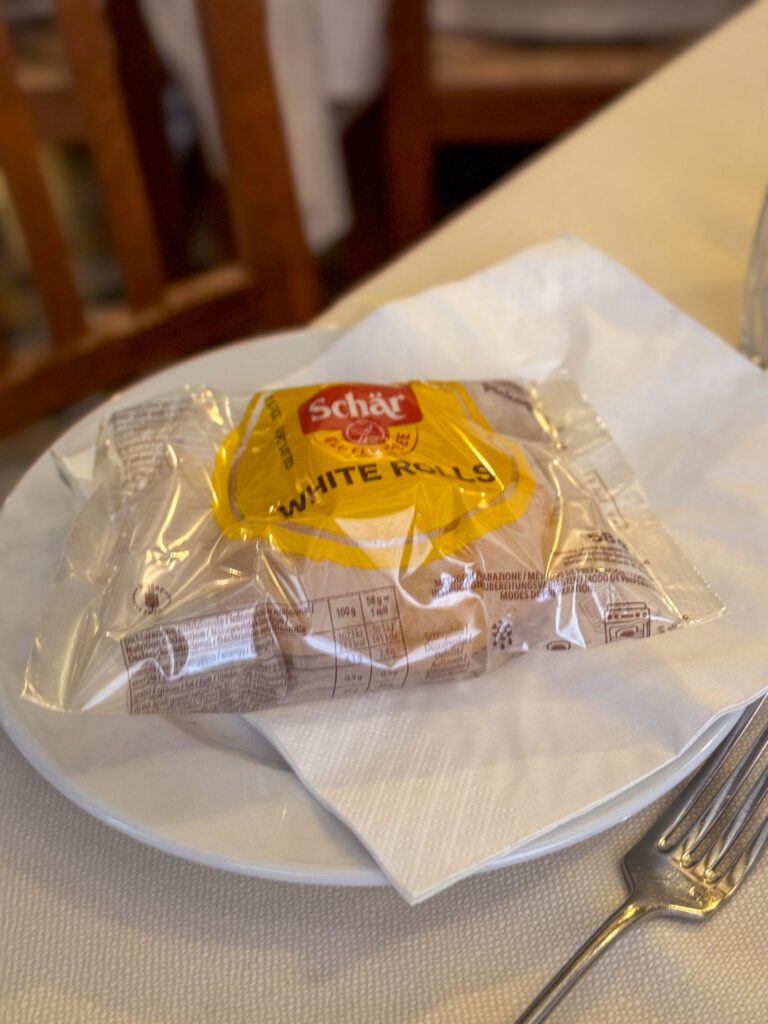

They have the third thing I was looking for, seppie al nero (cuttlefish in a black ink sauce), which is the main dish that I ordered.
It was really interesting, and the sauce in particular did not taste the way it looks (it was almost sweet, which makes sense because the base is garlic, onion, and tomato).
It’s served on a bed of polenta, which is historically the grain of choice in the lagoon (though pasta is plenty prevalent nowadays), and the interior of the restaurant features hanging copper pots, the traditional way to prepare polenta.
They also have a range of baked fish dishes and pasta dishes to choose from that can be made gluten free.
The highlight is the outdoor terrace, which is in the garden of the former 15th Century Palazzo.
It was, however, closed when I was there in the early spring, so I ate in the wood-adorned interior (where they have the copper pots used to cook polenta hanging from the ceiling).
Grom (Dedicated Gluten Free)
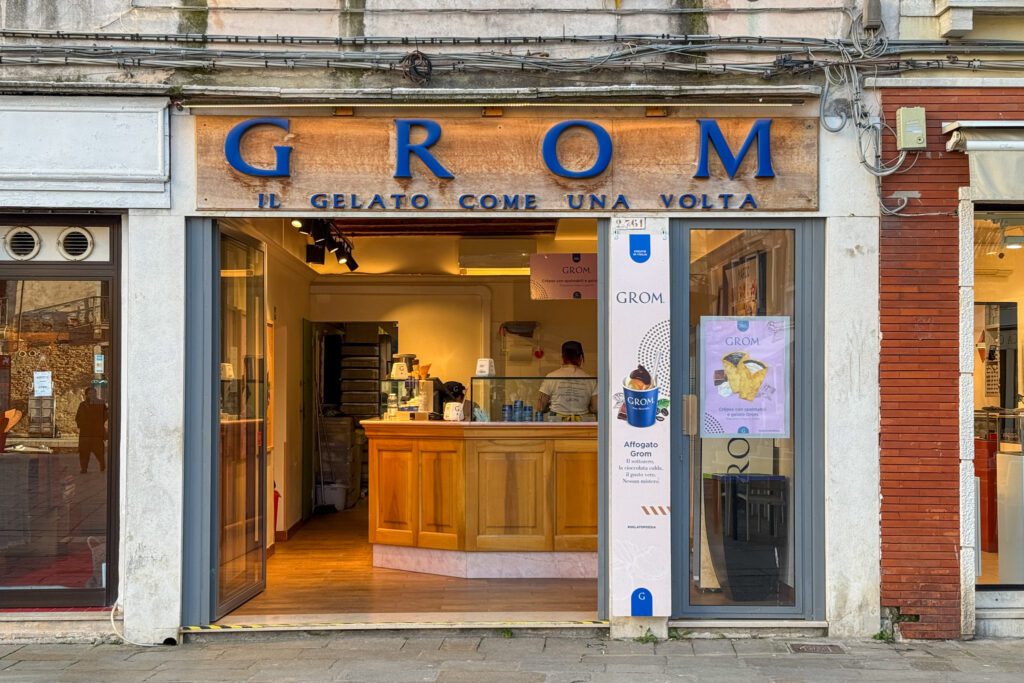
Look, Grom is a staple on any Italian gluten free city guide, and I’m consistently impressed with the quality of their gelato.
Yes, they’re a chain with locations across Italy (even spanning to Paris and beyond), but the thing is that they actually make really good gelato.
I’ve talked to several Italian food writers or experts, and the first thing most of them say about identifying high quality gelato is to look for gelato that is covered in stainless steel containers (rather than overflowing out of the container in huge colorful piles).
The second thing they usually say is to look at the color of the pistachio flavor, which should not be fluorescent green, but should be a slightly green-ish brown, which is the color of real pistachios.
Grom absolutely checks both of these boxes, with the added benefit that everything – including the cones – is gluten free, which means you don’t have to worry about cross-contact and asking for a scoop from a fresh container.
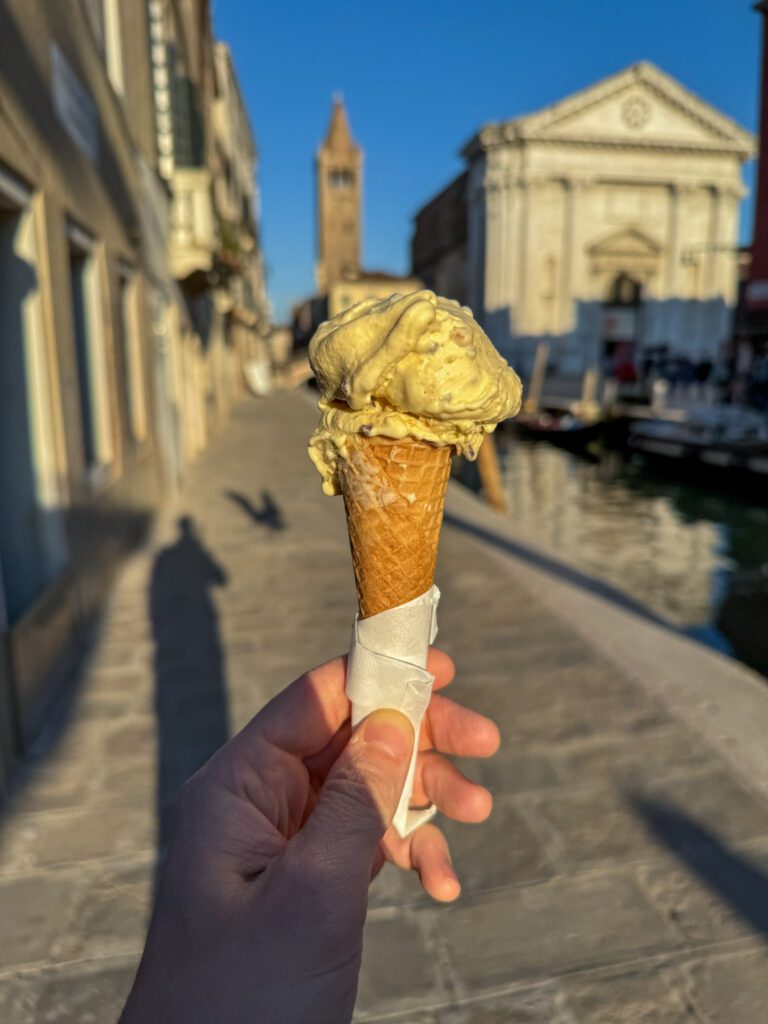
However, it is worth noting that the last time I checked, they use gluten free wheat starch in their cones (which is safe for Celiacs, but not for people with a wheat allergy).
I really like their pistachio and their gianduia e cioccolato (hazelnut chocolate), and it was a daily stop for me while I was in Venice.
Mea Libera Tutti (Dedicated Gluten Free)
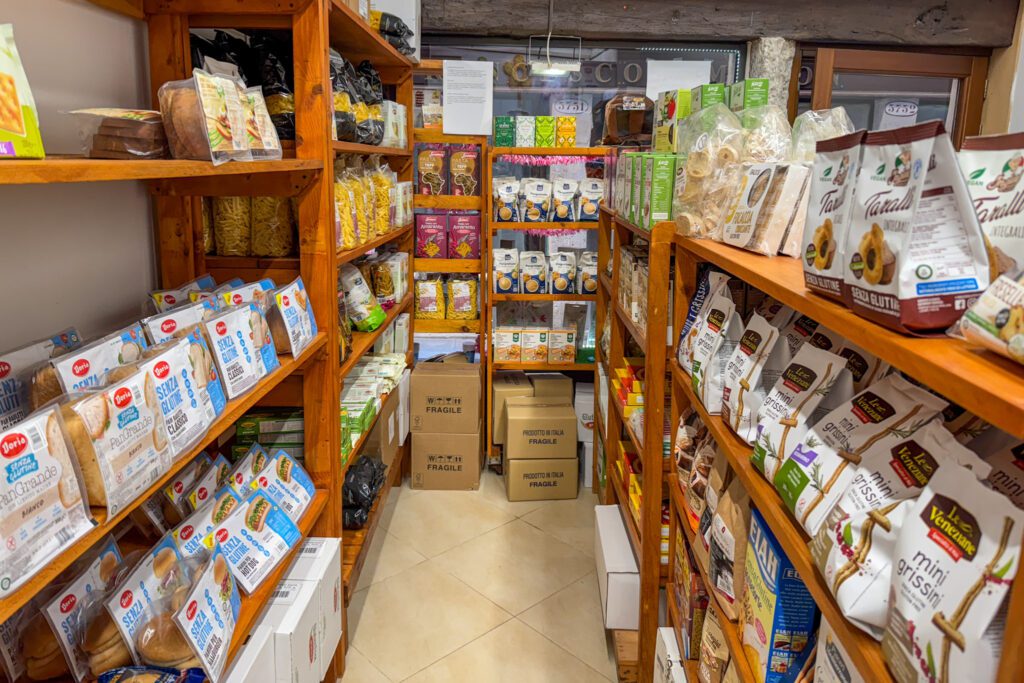
Mea Libera Tutti is not a restaurant or bakery, but is essentially a fully gluten free grocery store. Which isn’t super useful for visitors with a short visit (especially if you don’t have a kitchen), but it is worth noting that they have a nice selection of snacks (not to mention things that you can bring home with you to share with friends and family who are also gluten free).
I stopped by here and got a little selection of things to enjoy during my trip, including a couple of brioches and a frozen lasagna (to be completely honest, they weren’t very good and I should have stuck with my main squeeze in Europe, Schar, which is almost always pretty good).
However, another reason to stop here is the incredibly friendly owner, Erico, who started this business more than a decade ago because his son was diagnosed with Celiac Disease and he wanted to give other Celiacs options.
He’s a wealth of knowledge about the gluten free scene in Venice, and was happy to share his recommendations as I was checking out and asking about specific restaurants I was interested in.
I wouldn’t just stop by and ask him questions, though – make sure to pick up a few snacks and treats to support his business (I’m sure it’s tough to operate in central Venice these days).
Where to Find Gluten Free Groceries in Venice
If, like me, you are staying for a bit longer than the average tourist, have access to a kitchen, and are looking for places to find gluten free groceries to cook a few meals for yourself while you’re in Venice, here’s my take.
First of all, for the absolute best selection and friendliest service, stop by the aforementioned Mea Libera Tutti, which has the best selection of gluten free pastas, breads, treats, frozen meals, etc etc.
Other than that, there are basically three main grocery chains throughout Venice – Despar, Coop, Conad – all of which have multiple locations around the city that vary fairly widely in size and gluten free selection.
As a former food industry marketer, I LOVE going into grocery stores (bonus if they have a good gluten free selection) and just poking around. Which sometimes drives Alysha nuts, but she’s usually a good sport.
After visiting what feels like at least half of the locations of the chains listed above, I have some thoughts.
The Despar location near San Marco (here it is on Google Maps) had the best selection of pasta, pesto, sauces, meats, etc etc of any of the locations I went to.
Planning a trip to Italy? We’d love to help!
Here are our other Italy travel guides to help you plan an incredible trip (even if you have to eat gluten free!).
If there’s no link below, it means we’re still working on it – long, in-depth guides take time! We’re working on it, though, we promise.
If you’re planning a trip and you’re not sure where to start, your first stop should probably be one of our detailed itineraries.
We have a two week Italy itinerary that blends the main cities with some less-visited cities that we love (BOLOGNA!), a guide to spending 10 days in Italy that focuses mostly on the highlights, and a whirlwind guide to spending one week in Italy that features the Rome – Florence – Venice highlight circuit.
We also have a guide covering important tips for traveling to Italy for the first time, which is a collection of things we’ve learned over the course of our time in Italy that will help you have a smoother, more immersive trip.
Here are more specific guides to the main cities in Italy.
Rome
- What to do in Rome (as a First Timer)
- How to Plan an Amazing 4 Day Rome Itinerary
- Where to Stay in Rome: A Complete Guide for First Timers
- 26 Things to Know Before You Visit Rome
- Gluten Free Rome: A Complete Guide to GF Restaurants + Bakeries
- Where to Find the Best Specialty Coffee in Rome
Florence
- What to do in Florence (as a First Timer)
- How to Plan an Amazing Florence Itinerary (3 Days)
- Where to Stay in Florence: A Complete Guide for First Timers
- Gluten Free Florence: A Complete Guide to GF Restaurants + Bakeries
- Where to Find the Best Specialty Coffee in Florence (for Coffee Nerds)
- The Best Day Trips from Florence (Complete Planning Guide)
Venice
- A Perfect 3 Day Venice Itinerary (for First Timers)
- Exactly What to Do in Venice (As a First Timer)
- Where to Stay in Venice: A Complete Guide
- Gluten Free Venice: A Complete Guide (for Foodies)
Bologna
- What to do in Bologna (as a First Timer)
- How to Spend One Incredible Day in Bologna
- How to Plan an Amazing Bologna Itinerary (2 Days)
- Where to Stay in Bologna: A Complete Guide for First Timers
Cinque Terre
- What to do in Cinque Terre (as a First Timer)
- How to Plan an Amazing Cinque Terre Itinerary (2 Days)
- Where to Stay in Cinque Terre: A Complete Guide for First Timers
Milan
- What to do in Milan (as a First Timer)
- How to Plan an Amazing Milan Itinerary (2 Days)
- Where to Stay in Milan: A Complete Guide for First Timers
- Gluten Free Milan: A Complete Guide to GF Restaurants + Bakeries
The Rest of Italy

